Parameters of Sound
Connections
 The most neglected part of an audio or video setup is the connection between components. The tiny junctions that allow temporary connections present considerable obstruction for the simple flow of electrons which we recognize as sound or picture. A bad connection can severely affect performance of a carefully planned and installed system. Good connectors and cables come at a premium, but they significantly improve efficiency too. Usually all signal cables carry extremely small voltages for interconnection, cables and connectors themselves have resistance, capacitance, etc, which further deteriorate the signal strength. Poor quality signals, find it very difficult to surpass all these obstacles and reach their defined destination. Ideal connection is supposed to be absolutely clean and gas-tight to prevent any dust particle, dirt, contaminants which could oxidize or foul connection. A gas-tight connector is virtually impossible as the mechanical and electrical constraints are too high to achieve. Basic design of RCA and XLR connectors are common but are giving way to better connectors aided by high end equipment manufactures. Even a brand new cable has to be thoroughly cleaned before installation as they too contain variety of oils and chemicals used during manufacturing process. Clean and tight connections are essential for good performance. Power supply connectors have to be in good shape for noiseless sound as any loose connection can lay huge stress; on the power supply circuitry to maintain voltage necessary for internal use, which results in poor output.
The most neglected part of an audio or video setup is the connection between components. The tiny junctions that allow temporary connections present considerable obstruction for the simple flow of electrons which we recognize as sound or picture. A bad connection can severely affect performance of a carefully planned and installed system. Good connectors and cables come at a premium, but they significantly improve efficiency too. Usually all signal cables carry extremely small voltages for interconnection, cables and connectors themselves have resistance, capacitance, etc, which further deteriorate the signal strength. Poor quality signals, find it very difficult to surpass all these obstacles and reach their defined destination. Ideal connection is supposed to be absolutely clean and gas-tight to prevent any dust particle, dirt, contaminants which could oxidize or foul connection. A gas-tight connector is virtually impossible as the mechanical and electrical constraints are too high to achieve. Basic design of RCA and XLR connectors are common but are giving way to better connectors aided by high end equipment manufactures. Even a brand new cable has to be thoroughly cleaned before installation as they too contain variety of oils and chemicals used during manufacturing process. Clean and tight connections are essential for good performance. Power supply connectors have to be in good shape for noiseless sound as any loose connection can lay huge stress; on the power supply circuitry to maintain voltage necessary for internal use, which results in poor output.
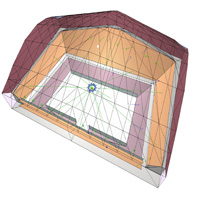 Acoustics
Acoustics
The single most important and influential link in the audio reproduction chain is also the least understood and most neglected- the listening room itself. This is unfortunately the most difficult and costly component to change. Three important factors for acoustics correction are room size, rigidity, mass, and reflectivity.
Room Size
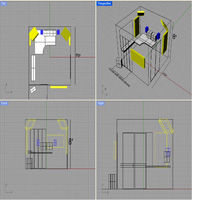 The dimensions height, width and length of the room and another main factor to be considered is the cubic volume. Practically room volume will be important criteria in choosing speakers, and amplifiers necessary to drive them to the required sound pressure level (SPL) or loudness (volume).Smaller area require smaller speakers whereas a larger one require bigger system).
The dimensions height, width and length of the room and another main factor to be considered is the cubic volume. Practically room volume will be important criteria in choosing speakers, and amplifiers necessary to drive them to the required sound pressure level (SPL) or loudness (volume).Smaller area require smaller speakers whereas a larger one require bigger system).
Dimensions of the room and their ratios do much to influence sound in the listening room. Height, width and length will determine the resonant frequencies of the space, as also the placement of speakers and the listener. The diagonal, the longest room dimension, will determine the ability of the room to support low frequencies. Ideally diagonal dimension is equal to or greater than the wavelength of the lowest frequency like to generate in the room. A 20 Hz wavelength is 56.6 feet in length, which is not practical for almost everyone.
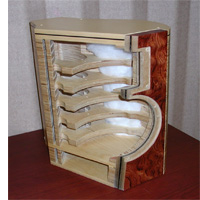 Rigidity And Mass
Rigidity And Mass
These play a significant role in determining how a given space will react to the sound within. They have a strong relation to low frequencies, qualitatively and quantitatively. Low frequency can be tremendously powerful, capable of flexing walls, ceilings and occasionally floors. To illustrate this phenomenon- imagine a room as a small box made of cardboard, the walls vibrate easily, the same box made of concrete will exhibit little movement, this is known as diaphragmatic action. This action dissipates low frequencies robbing the bass of both impact and extension. An ideal room should have absolute rigidity and infinite mass. To reduce diaphragmatic action we should increase rigidity and mass of all surfaces within the listening room, which can dramatically improve low frequency detail, solidity and overall accuracy. During construction stage these changes are inexpensive.
Reflectivity
 in simple terms, reflectivity is liveness of a room. Professionals prefer the term reverb time or Rt-60 is defined as the amount of time (in seconds) it takes for a pulsed tone to decay to a level 60dB below the original intensity. A live room is of greater reflectivity, and hence a long Rt-60, while a dead room has shorter duration. Rt-60 measurements are most useful in determining acoustic properties of larger spaces such as churches, theatres, auditoria, etc and in smaller environs the Rt-60 measurements are very short to be useless. Individual reflections from nearby surfaces are of primary importance in such spaces.
in simple terms, reflectivity is liveness of a room. Professionals prefer the term reverb time or Rt-60 is defined as the amount of time (in seconds) it takes for a pulsed tone to decay to a level 60dB below the original intensity. A live room is of greater reflectivity, and hence a long Rt-60, while a dead room has shorter duration. Rt-60 measurements are most useful in determining acoustic properties of larger spaces such as churches, theatres, auditoria, etc and in smaller environs the Rt-60 measurements are very short to be useless. Individual reflections from nearby surfaces are of primary importance in such spaces.
Reflections are desirable and detrimental, which depends on the frequency, level and the amount of time it takes for the reflections to reach our ears following the direct sounds produced by the speakers. Human brain blends together all the sounds reaching our ears within 5-30ms of the original and any reflection arriving approximately 30-50ms or more after the original, will be perceived as separate sounds. This phenomenon is known as Haas effect. It is these initial reflections that are most important to the brain in determining the apparent size of the listening room. Manipulating the ratio of direct vs. reflected sound, we can fool the brain to perceive to be in a larger room than it actually is. Reinforcing the direct output from the speaker with reflections of proper level, frequency and arrival time by eliminating the detrimental ones can be accomplished by proper positioning of the speaker and listener and also through implementation of various acoustic correction materials.
Comb Filtering
is a form of unwanted reflection, when a speaker is placed near a wall, floor, furniture etc, which results in image smear, and or frequency response anomalies. Comb filter effect occurs when the direct sound and the reflected sounds arrive at the listeners’ ears out of phase, thus cancelling each other. This problem can be avoided by placing speakers away from reflective surfaces, or by treating nearby problem areas with absorptive and or diffusive materials.
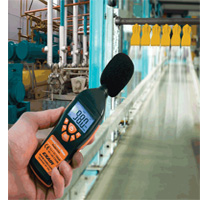 Simple Test
Simple Test
can help us to identify problematic reflections in our listening rooms. Simply sit in your normal listening position and clap your hands once, listen carefully to how sound is affected, do you hear a slow even decay, a single hard reflection or a multiple of closely spaced repeats. These faster echoes are known as flutter echoes and are created when sound bounces back and forth between two reflective surfaces. Judicious use of acoustic correction materials can be of great help.
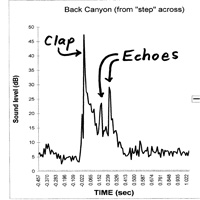 Flutter Echoes
Flutter Echoes
(To eliminate flutter echoes, damping one or both reflective surfaces creating problem will be an ideal solution).As these occur between two parallel walls or surfaces, damping one of these surfaces should control or eliminate the problem. Small rooms are often filled with flutter echoes and are major causes of imaging problems.
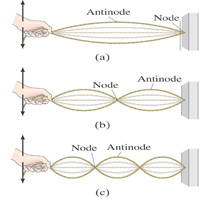 Standing Waves
Standing Waves
acousticians use the term room modes to define this effect which are low frequency reflection, caused by dimensional relationship within the room. Low frequency standing waves can be predicted mathematically when dimensions are known. Standing waves build up in the listening environment and conspire to sabotage the low-end performance of speaker systems. Low-frequency standing waves bloat the character of bass, causing severe peaks at points throughout the range.
Judicious Acoustics
Reflection of sound has to be controlled but not to be eliminated. Many acoustic treatment products exist in the market today; each has its own merits and is designed for treatment of specific problems. It is rather unwise to acquire any of them without prior understanding of the particular room deficiencies. Each of the currently available acoustic control materials represents an effective means of subduing or removing a variety of room problems. Diffusers are a type of material used for dispersing hard reflections in a random manner, eliminating reflections as well as absorbing them. Acousticians argue for diffusers as it returns energy back into the room in the form of ambience.
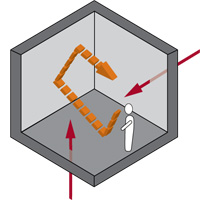 Early Reflections
Early Reflections
Sound waves that emanate from a speaker are similar to a beam of light radiating from its source, and as the beam of light which reflects off from nearby surfaces. These reflections can be beneficial or disturbing depending upon their intensity and time of arrival, in relation to the direct sound from the speaker. Reflections arriving too soon can be confusing to the brain and ear and also distorted imaging. Early reflections can be treated and easily corrected by placing a mirror at ear level along the wall and finding reflections of speakers in the mirror at different places, then marking these spots and placing diffusers or damping materials at these spots.
HD Sound
 high definition sound offers multiple channels of digital surround sound, and higher quality surround sound, just as high definition provides five times as much picture information as standard definition video, so high definition sound also provides a lot more audio detail and involvement to sound tracks. Normal audio CD provides only two channels of reproduction at 16-bit with a sampling rate of 44.1k, whereas DVD-audio gives six channels of audio at 24-bit with a sampling rate of 48k. These figures mean that they have better details embedded in them and with surround channels they allow all instruments to be pulled apart and delivered into our room without being mashed together in a confusing way.
high definition sound offers multiple channels of digital surround sound, and higher quality surround sound, just as high definition provides five times as much picture information as standard definition video, so high definition sound also provides a lot more audio detail and involvement to sound tracks. Normal audio CD provides only two channels of reproduction at 16-bit with a sampling rate of 44.1k, whereas DVD-audio gives six channels of audio at 24-bit with a sampling rate of 48k. These figures mean that they have better details embedded in them and with surround channels they allow all instruments to be pulled apart and delivered into our room without being mashed together in a confusing way.
And so it is with movies and now with HD TV shows too, where full 7.1 channel digital surround sound is improved enormously. It is far easier to comprehend the dialogue as is delivered from the centre speaker and the music, ambience and effects are mixed in other channels. For the movies with 7.1 Digital, surround sound envelopes you into sound. HD sound is in addition to the extra channels, more accurate, more truthful that’s because new technology has allowed to eliminate older compromises. The old Dolby surround from the 1970s was quite restricted to sound quality, but the Dolby Digital 5.1 available on some HDTV shows’ deliver excellent quality all around. Blu-ray steps things up even more, providing super-high resolution sound formats such as Dolby True HD and DTS-HD Master Audio. True HD sound has capability of 7.1 channel with 24-bit at 96-khz as the sampling rate, the benefits of these improvements are rather technical. Each increase allows the original sound to be more precisely and truthfully replicated. HD sound is proliferating, not all HD sound is the same but at least it is the basic requirement and is becoming increasingly common on TV shows and movies. HD sound is also available on most DVDs, most modern gaming consoles and also on Blu-ray.
Many modern movies create their atmosphere from the surround sound.
Scary movies and thrillers like to have sounds sneak up behind you.
Movie dialogs become clearer.
High resolution surround sound involves you in the screen action.
 HD Video
HD Video
High definition is the extreme level of resolution offered within the digital television category. Digital cable is available in three formats – standard, enhanced and high definition. Standard has a resolution of 480i, enhanced is 480p, and high definition is 720p and full high definition is 1080i. HD is a digital format but, not all digital video is HD. Picture on a screen or TV is composed of many independently scanned lines put together by two scanning techniques progressive and interlaced. 720p resolution is a TV with 720 progressive scanned lines. Progressive scan will show a clearer picture, mostly HD programming is available in 1080i or 1080 interlaced.
Aspect ratio is another factor for consideration; it is the ratio between the length and width of the screen. Older formats of digital and analog TV signals supported 4:3 formats where the screen was almost a square, according to research advancements it was revealed that the human vision is more horizontally oriented and hence came 16:9 formats where the screen is much wider as in movie theatres.


